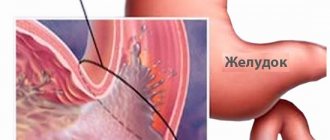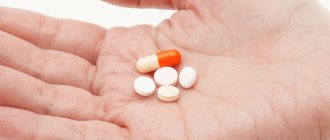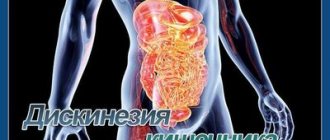Dyspepsia
The term "dyspepsia" comes from the Greek "dys", meaning "bad", and "pepsis", meaning digestion. Dyspepsia is a symptom, not a diagnosis. The term covers a wide range of symptoms that include upper abdominal pain or discomfort, bloating, early satiety, postprandial fullness, nausea with or without vomiting, anorexia, GERD symptoms, regurgitation and belching.
Multiple causes of dyspepsia can be classified as organic or functional. Organic causes include esophagitis, gastritis, peptic ulcer disease, benign esophageal angina, upper gastrointestinal malignancy, chronic intestinal ischemia, intestinal overgrowth or intestinal dysbiosis, pancreatic dysfunction, and pancreatic disease.
In addition, several medications can cause dyspeptic symptoms. The most notable are non-steroidal anti-inflammatory drugs (NSAIDs), which can cause mucosal damage leading to gastritis. Functional dyspepsia excludes all organic causes.
Previously, the Rome II criteria defined functional dyspepsia as pain centered in the upper abdomen on normal endoscopy, with three main subtypes: ulcerative, dysmotyl-like, and unspecified (nonspecific). Recognizing that patients with functional dyspepsia may present with epigastric symptoms other than pain, the revised Rome III criteria in 2006 added bothersome postprandial fullness, early satiety, and epigastric blood burning to the diagnostic criteria.
Thus, functional dyspepsia is now defined as "the presence of symptoms believed to originate in the gastroduodenal region, in the absence of any organic, systemic or metabolic disease that can explain the symptoms." In addition, previous subtypes have been revised to improve their clinical usefulness.
According to the Rome III criterion, the functional symptoms of dyspepsia are divided into two main, clearly defined disorders: post-traumatic distress syndrome and epigastric pain syndrome. Postprandial distress syndrome includes abdominal bloating, fullness, or early satiety with meals, while epigastric pain syndrome is defined by focal burning or pain localized to the epigastric region not related to the gallbladder or biliary causes. Postprandial distress syndrome and epigastric pain syndrome may coexist in patients with functional dyspepsia.
Types of dyspepsia
According to the latest scientific data, functional dyspepsia is divided into two clinical syndromes: postprandial distress syndrome (PDS) and epigastric pain syndrome (EPS), each of which is characterized by its own set of symptoms. To make a diagnosis, it is considered relevant to have them present within the last three months, no less.
With PDS, signs of trouble appear as a feeling of a full stomach when eating a regular portion of food. This symptom appears once a week or more often. The second sign is a periodic (several times a week) inability to finish the usual portion of food, that is, early satiety. It is also possible to experience nausea immediately after eating and occasional strong belching. Sometimes mild pain in the stomach area may occur.
With EBS, epigastric pain occurs once a week or more often, and can be aching or burning. The pain is clearly localized, does not radiate anywhere, and does not shift. The area of pain does not expand. The pain is not associated with the passage of food through the digestive system and is not similar to that which occurs when the functions of the biliary tract are impaired.
Modern aspects of the treatment of functional dyspepsia
Professor Drapkina O.M.: – We are starting the “Gastroenterology” section. And the first message in this section will be made by Professor Vladimir Ilyich Simanenkov. Vladimir Ilyich, hello!
Professor Simanenkov V.I.: – Hello!
Professor Drapkina O.M.: – Modern aspects of the treatment of functional dyspepsia.
Professor Simanenkov V.I.: – Dear colleagues! Naturally, in a short message I will not be able to cover all aspects of this suffering, and I will try to focus on issues of therapy. And, nevertheless, a few words first about what kind of definition this is? Because in ICD-10 there is no diagnosis of functional dyspepsia. There are sections: K30 Dyspepsia, K31 Functional indigestion and K29 gastritis. We also have section F in ICD-10, and there are somatophoric disorders. But I think that gastroenterologists and therapists do not look at this section of ICD-10 so often.
At the same time, look at the domestic data from the highly respected director of our school, no, scientific director, Academician Ivashkin, Western data that almost a third of the population has functional dyspepsia. And look at this slide. According to Western data, a quarter of people over 65 years of age have functional dyspepsia. I often ask doctors during improvement cycles: “Who diagnosed functional dyspepsia over the past year?” And very rarely do hands go up. That is, dear colleagues, in our country the diagnosis of “functional dyspepsia” is often drowned in the diagnosis of “chronic gastritis”. I may touch on this later.
If you look at old data, in the 18th century dyspepsia syndrome was still associated with nervous disorders, with hypochondrization of patients with hysteriform disorders. And one of the leaders of functional gastroenterology, American professor Duck Drossman, who is a professor in two specialties, psychiatry and gastroenterology, began to formulate his biopsychosocial model back in 1998. And in the last Roman criteria III it is also presented. And pay attention to personality traits, stress, motor disorders, secretory disorders, Helicobacter. But in recent years it has turned out, in a number of studies, that genetics also plays a certain role. This is what I said, the other one is just a picture of other authors, but the essence is the same.
So about genetics. The work of the 11th year analyzed a number of genetic prerequisites, and it turned out that the peculiarity of the functioning of mediator systems is genetically transmitted. And first of all, we are talking about the serotonergic and catecholamine system. This is very interesting, because it speaks about the points of application of a number of drugs.
How significant is functional dyspepsia for a person? It was found that the degree of reduction in quality of life is comparable to bronchial asthma and IBD - inflammatory bowel diseases. That is, it would seem that there is either no organic substrate at all, or it is minimally expressed, and the quality of life is significantly reduced due to symptoms associated with pain, a feeling of fullness in the stomach, etc. And what does prolonged pain syndrome, prolonged dyspeptic syndrome lead to? It leads to the development of personality disorders and the development of anxiety and depressive symptoms. And St. Petersburg professor, psychiatrist Nina Pavlovna Lanchakova, showed back in 2007 that the differentiated use of psychotropic drugs increases the effectiveness of treatment many times over. Here are the main motor variations that are observed in functional dyspepsia. And pay attention, often we are talking about desynchronosis, that this coordinated change in tone from top to bottom of the stomach, antrum, pylorus, bulb, etc., is disrupted, and in addition, duodenogastric reflux and gastroesophageal reflux can occur. That is, we are talking primarily about secretory-motor dissociation and dysrhythmia.
Now here is a problem that has not been fully resolved - the problem of the relationship between functional dyspepsia and chronic gastritis. At the beginning of my report in the message, I already said that in our country the issue is being resolved in favor of the diagnosis of “chronic gastritis,” but in Western European countries, even in the presence of morphological signs of gastritis, the diagnosis of “functional dyspepsia” remains. This is why epidemiological comparisons are extremely difficult. I am forced to express my point of view, because usually in reports we operate on the results of consensuses, the results of classifications, and the results of studies conducted in line with evidence-based medicine. It seems to me that both terms – gastritis and dyspepsia – should probably be present in the diagnosis. Why can’t we stay only within the framework of the diagnosis of “gastritis”? It seems that chronic gastritis has no specific symptomatology. I emphasize once again that this is the position of your humble servant; it does not pretend to be final and indisputable.
In the Roman criteria, only 3 syndromes were classified as dyspeptic syndrome: a feeling of fullness in the epigastrium after eating, early satiety, pain or burning in the epigastric region. And a new duration of clinical symptoms was determined.
Dear colleagues, what is the nature of this description “the last 3 months over 6 months”? Negotiable, consensual - experts gathered and agreed. At the moment, this consensus is working, but this does not mean at all that some time will pass and our ideas will change and our criteria will change. That is, I emphasize once again that the Rome III criteria are negotiable and consensual in nature.
Now let's talk about terminology. Many colleagues who are now online know that 2 new terms have appeared. These are epigastric pain syndrome - EPS, and postprandial distress syndrome - PDS. They are presented here too. As for epigastric pain syndrome, it seems to me that this does not cause internal tension and rejection in us. But as for the term “postprandial distress syndrome” - this is a rather controversial term, because, if we remember Hans Selye and his understanding of the term distress, then we are talking about pronounced, severe stress, to which it is difficult to adapt. Can we call this feeling of fullness and heaviness in the epigastric region that occurs after eating distress syndrome? Probably with some degree of convention. In any case, dear colleagues, we currently have this consensus, and we will probably use these two options for the diagnosis of dyspepsia syndrome.
Now another controversial point is the relationship between functional dyspepsia and IBS. In all criteria, stool disorder excludes functional dyspepsia, and vice versa. But in life, overlap and comorbidity are extremely common. 2/3 of patients have symptoms related to functional dyspepsia, I mean patients with IBS. That is, probably, dear colleagues, the point is that motor-secretory and dysregulatory disorders often affect both the upper and lower parts of the gastrointestinal tract. This is another illustration of how arbitrary the exclusion criteria are.
Now let's move smoothly to therapy. There is little time, and we must, so to speak, move on. What are the challenges in assessing the effectiveness of treatments for functional disorders? Yes, in that they are not fatal, and there are no endpoints - life expectancy and mortality. We worked on this problem a lot, and I had a graduate student, Yulia Mikhailovna Gouman, and we figured out what we should rely on when assessing the effectiveness of therapy. And we came to the conclusion that we need to focus on global improvement, on the dynamics of clinical symptoms, and on the dynamics of quality of life indicators. This also corresponds with what is in foreign literature.
What is the goal of treating functional dyspepsia? Back in 2001, Vladimir Trofimovich Ivashkin wrote that the main goal of treating patients with functional dyspepsia is to improve the objective and subjective condition, including the elimination of pain and dyspeptic disorders. And to a certain extent, this corresponds to what was written earlier.
When I was preparing for this message, in general, I was dealing with functional dyspepsia, naturally, like many of you, I turned to the reviews of the Cochrane Library, the pronunciation of this word can be different, it doesn’t matter, and I found 38 reviews dedicated to functional dyspepsia. Various aspects were analyzed there, but I was naturally interested in therapy. And here are the main 6 reviews that were devoted to treatment. And do you see what was analyzed? The role of prokinetics in functional dyspepsia, does eradication of Helicobacter pylori affect non-ulcer dyspepsia, how to treat non-ulcer dyspepsia in general, does acupuncture help, do antidepressants and tranquilizers help, and finally, does Chinese traditional medicine help with functional dyspepsia. I will probably not touch upon the issues of traditional approaches of acupuncture and Chinese medicine in this message, but will rather touch on other points.
What are the main medicinal approaches in the treatment of functional dyspepsia? Here, dear colleagues, it is written about medications. But in my deepest conviction, if your patient has not changed his lifestyle, then you can prescribe him any number of medications, this will not radically change the course of the disease. What does lifestyle mean? First of all, these are, of course, dietary recommendations and, above all, it seems to me extremely important that the patient does not break the nutritional stereotype that has been developed over centuries in a given region, etc. Functional dyspepsia is dysrhythmia. This means that dysrhythmia must be contrasted with rhythm, the rhythm of nutrition, both in volume and quality.
Moving on to medications, I would like to note one important detail. Look, the first point for epigastric pain syndrome is acid-suppressive drugs, and first of all, proton pump inhibitors and H2 blockers. There are few direct comparative studies of these two groups, but in functional dyspepsia, a significant advantage of proton pump inhibitors over H2 blockers has not been shown, unlike other acid-related diseases. And this is understandable, because with functional dyspepsia there is no true hypersecretion of hydrochloric acid. It has been shown that at night they produce more hydrochloric acid, the postprandial production of hydrogen ions differs from healthy ones, etc. But still, of course, there have been more studies in which proton pump inhibitors were used in recent years.
Regarding the dosages, it must be said that, of course, these are not the doses that we use for gastroesophageal reflux disease or during eradication therapy; here we use either half doses or the usual dose. If we take omeprazole as a starting point, for example, it means either 10 or 20 milligrams per day, which is usually sufficient. For postprandial distress syndrome, the key group of medications, of course, are prokinetics, and I’ll talk about them in a little more detail.
As for combination therapy, yes, there are now quite a lot of drugs that combine either a proton pump inhibitor and a prokinetic agent, or a proton pump inhibitor and an antacid, which is absorbed more often. But the point is that then we move a little further towards differentiated therapy. Regarding eradication therapy, we will say a little lower.
Regarding psychopharmacotherapy. Dear colleagues, at our department, psychopharmacological agents that are used in the clinic of internal diseases have been studied for many years. And we have shown that when we use, for example, an antidepressant, anxiolytics in the clinic of internal medicine, we not only positively influence the psychological characteristics of the patient, but also change the course of somatic suffering. Therefore (but more work, of course, on antidepressants) has shown a fairly high effectiveness of antidepressants for functional dyspepsia. Of course, two groups of antidepressants are most widely used. These are tricyclic antidepressants, examples include azafen, aminotriptyline in small doses, and so-called serotonin-positive antidepressants, that is, drugs that affect the reuptake of serotonin. This is escitalopram, this is sertraline and a number of other drugs.
What's special about this? Tricyclics - they have an additional, anticholinergic effect, so they are more beneficial to prescribe for epigastric pain syndrome. And serotonin-positive ones, as the name suggests, stimulate motor skills, so they are more beneficial to prescribe for postprandial distress syndrome.
Now there is no time to discuss for a long time, maybe a gastroenterologist and a therapist can prescribe them, they can’t, my point of view, just as it is reflected in the documents of the Ministry of Health, they can. But there is simply no time to dwell on this for long.
Here are the main prokinetics. And you see, dear colleagues, that the problem with many new drugs, and not very many, is the effect on the cardiovascular system. Anyone who has worked longer remembers with what pleasure cisapride was used at one time, and what happened. It turns out that, unfortunately, it affects the QT, lengthens it and leads, or may lead, to undesirable events from the cardiovascular system. The same situation happened with tegaserod.
What do you and I have in our arsenal? Here we have metoclopramide, unfortunately, it causes extrapyramidal disorders, drowsiness and fatigue, so now it is used more often as an antiemetic. You and I have domperidone, and initially we generally hoped that it was a purely peripheral drug. But as our clinical experience accumulates, reports have appeared about the possibility of developing such undesirable phenomena due to the fact that against the background of blockade of D2, dopaminergic receptors, the second type of receptor, there is an increase in prolactin levels with the possibility of galactorrhea, menstrual irregularities and gynecomastia. Here is its clinical effect. It increases the tone of the lower esophageal sphincter, enhances accommodation, etc.
As for cisapride, I said it. Mosapride - we have hopes for this drug, but you see that, unfortunately, it causes cytolysis syndrome and increases triglyceride levels in a number of patients.
And finally, perhaps the last one on our pharmaceutical market is the prokinetic drug itopride. You see that it has a dual action, it blocks, like other prokinetics, dopaminergic receptors of the second type, and at the same time blocks cholinesterase, and due to this, the activity of adenylate cyclase in smooth muscle cells increases and increased motor activity occurs. Why does itopride act mainly on the upper gastrointestinal tract? The fact is that the density of D2 receptors in the upper sections is higher. This diagram also shows the main mechanisms of its action. Dear colleagues, a lot depends on acetylcholine, so acetylcholine is still one of the key mediators of contractions.
You and I, dear colleagues, have 2 drugs of itopride. We have a branded drug and a generic Itomed. And naturally, the question arises: how equivalent are they? As you know, there are 3 types of equivalence: pharmacological, bioequivalence and therapeutic equivalence. According to regulatory authorities such as the Food and Drug Administration (FDA) and the European Medicines Agency (EMEA), bioequivalence implies therapeutic equivalence. There are no direct comparative studies yet, but they are planned, and then we will receive data on therapeutic equivalence or non-equivalence. It is impossible to guess, but it seems that the presence of bioequivalence is a prerequisite.
Here, dear colleagues, are the side effects. Why are there so many of them? Because a high-quality drug and a normal pharmaceutical company should include all undesirable effects in the instructions for use. If we look at allergic reactions, most often we are talking about hives. I have never seen anything more severe.
As for contraindications. Why is it not possible for people under 16 years of age? Why shouldn’t pregnant and lactating women? Only because there is no research. You know that conducting research on pregnant women and lactating women is practically never allowed.
Dear colleagues, there are quite a lot of studies on itopride. You see, it has been proven effective. Yes, and I am finishing my report. And dear colleagues, what would I like to emphasize at the end of my report? Maastricht 3 says that in countries with a high prevalence of Helicobacter, eradication should be carried out in patients with functional dyspepsia. Do we hope that eradication will radically improve the course of functional dyspepsia? Our clinical experience suggests that this is not the case. I thank you for your attention!
Causes of dyspepsia syndrome
Almost paramount importance in functional dyspepsia is given to various disorders of a psychological nature. The risk of it is extremely high in people prone to anxiety, suspiciousness, with a labile psyche, and in those who easily lose control of themselves under stressful conditions. Also, FD is often combined with sexual disorders, and this indicates a serious influence of the psyche on the disease.
There are also external factors that contribute to the development of the syndrome:
- smoking, which disrupts the normal motility of the digestive system;
- alcohol consumption affecting the nervous system;
- spicy foods that overly irritate the receptors of the gastrointestinal mucosa;
- regular use of non-steroidal anti-inflammatory drugs (aspirin, ibuprofen, diclofenac, etc.).
Introduction
The problem of functional disorders of the gastrointestinal tract (GIT) is extremely relevant due to its high prevalence.
Despite the fact that this pathology is associated with a good prognosis, the quality of life of patients is significantly reduced. This leads to frequent visits to the doctor, additional, often unnecessary, expensive examinations and ineffective treatment. According to the Rome IV criteria [1, 2], functional gastrointestinal disorders are based on combined morphological and physiological abnormalities:
gastrointestinal motility disorder;
decreased protective mucosal barrier and immune function;
changes in the composition of the intestinal microbiota;
visceral hypersensitivity;
violation of the coordinating function of the central nervous system.
The updated document makes several important additions. Thus, for the first time, the role of microbes and certain foods as etiological factors in the occurrence of functional disorders of the gastrointestinal tract has been officially approved. In addition, the concept of “crossover syndrome of functional disorders of the gastrointestinal tract” was introduced - the simultaneous course of several functional disorders or a transition from one to another.
Dyspepsia symptoms and diagnostic tests
First of all, the doctor pays attention to a feeling of heaviness or fullness in the stomach that lasts or occurs systematically for three months or more, occurring after eating, nausea, pain or discomfort in the epigastric region, bloating of the upper abdomen. Unfortunately, these signs are characteristic of many other diseases, and additional studies are prescribed to exclude them:
- general urine and blood tests, blood biochemistry;
- coprogram;
- esophagogastroduodenoscopy, if necessary accompanied by taking a piece of tissue for histological examination;
- testing for the presence of Helicobacter pylori infection;
- Ultrasound of the abdominal organs (liver, biliary tract/pancreas), etc.
The absence of deviations from the norm according to the results of all studies and examination of the patient makes us think about exactly one of the variants of functional dyspepsia.
There are, however, a number of signs in the presence of which the diagnosis of FD is excluded and another disease should be looked for:
- weight loss for no apparent reason;
- the presence of symptoms mainly at night;
- constant severe abdominal pain, which becomes the main symptom of the disorder;
- increased body temperature;
- enlarged liver, spleen;
- changes in leukoformula data, signs of anemia, changes in blood biochemistry.
These are “alarm symptoms” signaling the presence of an undetected organic pathology.
FZOP overlap syndrome
FPD crossover is a combination of diseases of one or more gastrointestinal tract organs with common proven or suspected mechanisms of pathogenesis. Statistical data indicate a high frequency of detection of cross functional disorders of the gastrointestinal tract: according to WHO, 42–87% of patients with IBS are diagnosed with FD [16], almost half of patients with IBS (49%) have disorders of the motor function of the biliary tract. It has been established that in patients with dyspepsia, the frequency of detection of IBS is significantly higher than in persons without FD (37% and 7%, respectively) [17].
In one study [18], the combination of FD with IBS was detected in 11–27% of cases, and the overlap of these functional disorders was associated with more severe clinical manifestations. The researchers called this phenomenon the “mutual burden” phenomenon. Thus, the intensity of postprandial fullness, painful feelings of hunger and the severity of heartburn were significantly higher in patients with a combination of two or more functional disorders than in patients suffering from only one functional disorder (p<0.001). The presence of the phenomenon of “mutual burden” had a significant negative impact on the quality of life and the effectiveness of treatment
Currently, despite its widespread prevalence, FPD crossovers are practically not diagnosed, and this is often the reason for ineffective treatment of patients. The purpose of identifying the overlap syndrome is to improve diagnosis and increase the effectiveness of therapy. Theoretically, in some cases, the use of one pathogenetic agent to varying degrees should affect the course of all combined diseases. In the case of a combination of functional disorders with various clinical manifestations (for example, the overlap of FD and IBS), it is logical to prescribe medications recommended for use in each of the pathologies. Thus, drug treatment of FD involves the use of proton pump inhibitors and prokinetics, as well as mandatory eradication of Helicobacter pylori
[3]. For IBS, the first-line drugs are myotropic antispasmodics in combination with medications that normalize the evacuation function of the colon, as well as pre- and probiotics [19].
Principles of dyspepsia treatment
The bad news: medication alone cannot cure dyspepsia. Doctors consider changing lifestyle, diet and diet, and overall health of the body almost more important than taking pills.
Excluding excessively fatty foods, alcohol, coffee, hot spices from the diet, as well as quitting smoking lead to a significant reduction in the severity of symptoms. With early satiety, bloating and nausea as the leading symptom, you should switch to 4-6 low-fat meals a day.
Drug treatment is prescribed if there is no success in transitioning to a healthy lifestyle, as well as if the symptoms of dyspepsia are severe:
- omeprazole or rabeprazole are prescribed to combat epigastric pain syndrome - these are the drugs of choice;
- Domperidone (Motilium) drugs are recommended for postprandial distress syndrome;
- antidepressants and sedatives help normalize the regulatory mechanisms of the gastrointestinal tract.
Diet recommendations
Nutrition plays a key role in treating the problem. A properly selected diet allows you to restore normal secretory function of the stomach, and also leads to a reduction in the clinical manifestations of the disease.
Patients are advised to avoid dairy products and legumes, as they can cause increased gas formation. Flatulence is one of the most common complaints in pathology, so a decrease in its intensity is associated with an improvement in well-being. Doctors advise eating 5-6 times a day. This approach helps eliminate high acidity and also leads to rapid evacuation of contents from the intestines. Salty, peppery, spicy and fried foods are excluded from the diet because they have an unnecessarily irritating effect on the gastric mucosa. Citrus fruits, alcohol, strong tea and coffee, as well as carbonated drinks are prohibited. Eating large quantities of sweets and baked goods is also not recommended.
Dyspepsia in children
This concept in pediatrics includes a whole group of disorders associated with similar symptoms:
- gastritis;
- peptic ulcer of the stomach and duodenum;
- pancreatitis;
- biliary dyskinesia;
- gastroesophageal reflux disease;
- colitis.
In addition, this can include banal intolerance to certain foods, and simply the body’s reaction to overeating. Infectious diseases are also included in this group, called putrefactive or fermentative dyspepsia.
Unfortunately, this diagnosis is a legacy of the past, when diagnostic methods were not enough, and doctors, apart from blood and urine tests, did not have any special examination capabilities. In fact, dyspepsia is not a disease, but a complex of symptoms and a diagnosis, for example, of “fermentative dyspepsia” only means that the doctor cannot, does not know how or does not want to carefully examine the child.
Functional dyspepsia is a real syndrome that brings significant discomfort in life. However, sometimes its symptoms accompany a very real disease. The Dobrobut.com website recommends a thorough examination, passing all the necessary tests and studies in order not to miss something more serious than just a violation of the regulation of digestion. Although the latter also needs to be treated.
The role of the central nervous system and psychosocial factors in the development of PVOD
It should be noted that another important reason for ineffective treatment is that both patients and doctors underestimate the importance of psycho-emotional disorders of the central nervous system in the form of anxiety and even depression. Meanwhile, according to international experts [20], in the development of functional diseases at all levels of the gastrointestinal tract, psychosocial factors are of decisive importance: stressful situations, psychological status, characteristic personal qualities and susceptibility to stress, overcoming difficulties (Fig. 1). Thus, in IBS, the predisposing background for the development of the disease is subjective, overly significant emotions for the individual, which cause overstrain of the autonomic nervous system, leading to disruption of their implementation in the form of verbal or physical expression of experiences. Pathology develops gradually, under the influence of a complex of factors throughout life, and in childhood and adolescence, environmental factors and family habits are of great importance.
Back in 2000, G. Engel proposed a biopsychosocial model of the development of IBS, in which a dysregulation occurs between the central nervous system and the autonomic enteric nervous system, which normally regulates the basic functions of the intestine - motility, absorption and secretion with minimal influence from the sympathetic and parasympathetic systems. In the presence of a sensitizing factor, any deviations in intestinal function cause activation of a large number of spinal neurons, leading to spinal hyperexcitability syndrome associated with the activation of a large number of nitric oxide molecules, while the corrective reflex response is perceived as painful [21, 22]. Genetic predisposition, combined with exposure to a sensitizing factor, may contribute to the formation of a long-lasting trace memory of pain in some individuals. Therefore, in the future, normal (not excessive) deviations cause an aggravated pain response, corresponding to the influence of a stressful sensitizing factor. Thus, in patients with IBS, the process of descending suppression of pain perception (central antinociceptive dysfunction) is impaired in the absence of damage to the neuronal transmission of visceral pain [21, 23, 24]. These processes underlie the formation of visceral hypersensitivity syndrome, in which WE Whitehead (2002) identified 2 types of visceral hyperalgesia: a decrease in the threshold for pain perception and a more intense sensation of pain with a normal threshold for its perception.
Numerous studies have shown that HHV, which in patients with IBS is the main factor in the formation of persistent, intense abdominal pain syndrome that is difficult to respond to traditional treatment, is characterized by selectivity in relation to mechanical stimuli, while the perception of electrical, thermal and chemical effects on the intestinal wall does not differ from that in healthy individuals. Visceral hyperalgesia is considered to be a biological marker of IBS, and the balloon dilatation test is a specific (95%) and sensitive (70%) method for diagnosing the disease [4, 21–25]. A predictor of the formation of HHV is the interaction of a complex of sensitizing factors: intestinal infection, psychosocial stress, physical trauma.
The complex interaction of psychosocial, physiological (increased sensitivity, etc.) and environmental factors creates disruptions in the interaction of the central nervous system with the peripheral part of the nervous system, which ensures the activity of the gastrointestinal tract (the so-called “brain-gastrointestinal tract” axis) [1]. Developed functional disorders, in turn, maintain and aggravate the imbalance in the regulation of gastrointestinal tract activity and, moreover, lead to pronounced disturbances in the psycho-emotional sphere. It is known that the quality of life of patients with FPD is significantly reduced compared to that in the general population, and ineffective treatment with traditional drugs further aggravates the emotional state of the patient due to fixation on his painful, “incurable” condition. For example, in severe cases of IBS, persistent clinical symptoms resistant to treatment are observed, while in all patients there is a connection between the disease and psycho-emotional problems, and in some cases there are already psycho-emotional disorders in the form of anxiety, depression, etc. In studies, concomitant functional autonomic disorders , affective and anxiety, depressive or hypochondriacal disorders are detected in 75–80% of patients with IBS [26].
Thus, the state of the central nervous system may be fundamental in the occurrence and progression of PDOP. That is why one of the main emphasis in the latest edition of the European recommendations is placed on the pronounced relationship of these disorders with perception disorders. Moreover, instead of the definition of “functional disorder” it is now recommended to use the definition of “disorder of cerebro-intestinal interaction”, and the definition of “functional abdominal pain” is recommended to be replaced by “impaired central perception of gastrointestinal pain” [1, 20].










